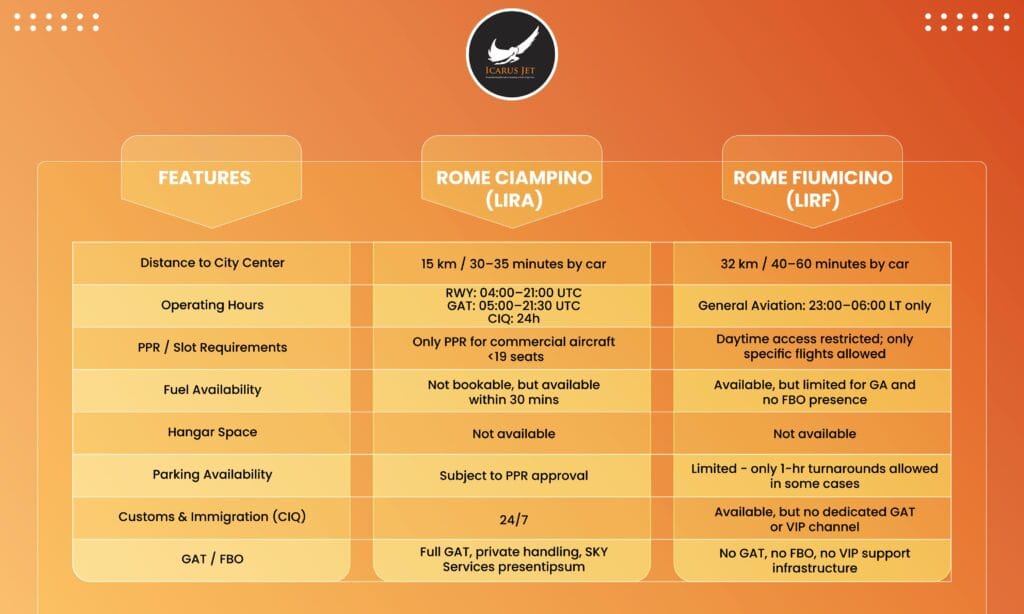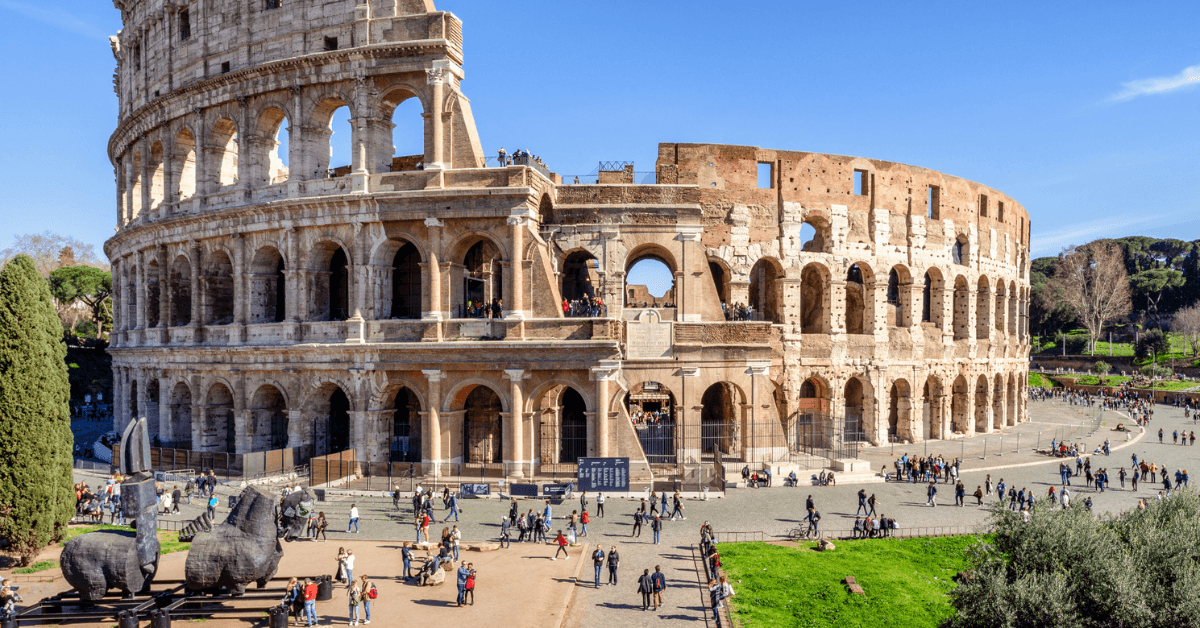When organizing a private jet flight into Rome, Italy, the airport choice will greatly affect operational efficiency, turnaround, and overall passenger and crew experience. There are two major airports in Rome: Rome Ciampino (LIRA) and Rome Fiumicino (LIRF). Both are international airports, but one is solely dedicated to business and general aviation.
In this guide prepared by our trip support team, we offer a full technical comparison of LIRA and LIRF to assist private jet crew, operators, dispatchers, and trip support personnel in making the most informed decision possible for flights into Italy’s capital.
General overview

Operational flexibility
While thinking about ground handling and trip support for private aircraft flights to Rome, proximity and distance from the city center are important factors to consider.
Rome Ciampino (LIRA) is situated approximately 15 kilometers southeast of downtown Rome. Passengers and crews can anticipate a 30 to 35-minute ground transfer to major city destinations, traffic depending. Because of its close proximity, it is ideal for VIP flights, diplomatic flights, or medical flights of an emergency nature.
Rome Fiumicino (LIRF), the city’s main commercial hub, is located about 32 kilometers to the west. Ground travel times are typically 40 to 60 minutes and are generally beset by delays caused by airport size and commercial traffic. For business aviation, this includes extensive ground time, undermining operational efficiency.
Runway and operating hours
LIRA has extensive operational coverage for private flying, with the runway between 04:00 UTC and 21:00 UTC and the General Aviation Terminal (GAT) between 05:00 UTC and 21:30 UTC. Customs and immigration is open 24/7, 24 hours a day, to facilitate international operations at any time.
On the other hand, LIRF is only open for general aviation traffic from 23:00 to 06:00 local time. Use during the day is heavily limited and only allowed under extraordinary circumstances, such as:
- Diplomatic clearances
- Ambulance or deportee flights
- Overflow operations when LIRA is at its maximum movement quota (1-hour turnaround only)
This operational constraint renders LIRF unsuitable for routine private jet flights, especially daylight flights or schedule flights of discretionary nature.
Trip support infrastructure: GAT, FBO, and VIP services
Trip support professionals and crews will find Rome Ciampino (LIRA) far more suitable for private aircraft handling. It boasts a dedicated GAT and SKY Services FBO with ground handling, customs clearance, and dedicated lounges for VIPs and crew. Handling is centralized and streamlined, making it easier to provide efficient services at all times, even at peak hours.
At Rome Fiumicino (LIRF), the scenario is completely different. There is no FBO, no GAT, and no VIP facilities for business aviation. Private jet passengers must transfer through commercial terminals using Cobus transfers, walk extensive distances, and retrieve their baggage on their own. The design does not provide crews with any facility to enter the terminal directly, and all handling services experience considerable delays.
This greatly detracts from the overall experience for high-status travelers and creates complexity for operators dealing with crew logistics or tight connections.
Fuel and parking availability
Fueling at LIRA is mostly reliable, although not pre-bookable. Refueling, on average, takes place within 30 minutes. Although not perfect for high-speed turnarounds, this is acceptable for the majority of operators with notice.
LIRF fuel services are commercially airline focused. Although fuel is available, there is no specific GA infrastructure, and crews can anticipate greater delays, particularly if attempting to refuel during airline peak periods. As handling support is limited, coordination of fuel uplift will also likely involve extra intervention on the part of the trip support provider.
LIRA parking is PPR-restricted, which is usually approved unless at maximum capacity. There is no full hangar capacity, but apron parking is adequate for the majority of mid-size and long-range corporate jets. Visitors should pre-plan and request PPR well in advance for overnight or high-season arrivals.
LIRF, due to its commercial nature and GA restrictions, only has limited apron access. Even on limited occasions when private flights are accepted during the day, a one-hour maximum turnaround is allowed for operators, with no overnight stays being accommodated. There is no hangarage available.
Customs, immigration, and crew handling
LIRA provides 24/7 immigration and customs and is the only viable alternative in Rome for foreign business jet arrivals at any time of day. The customs and immigrations process are accelerated through the dedicated GAT so that travelers are able to avoid commercial air traffic and long queues.
At LIRF, customs activities are included in the commercial terminal operation. Passengers and crews must move through the general public, proceed through regular baggage process, and experience increased waiting. Limited crew access and such basic services as catering, laundry, or passenger ground transportation can entail prolonged coordination due to facility design.
The verdict: Which airport is best for private jet operations?
From a trip support and operational efficiency standpoint, Rome Ciampino (LIRA) is the obvious airport of choice for a private flight to Rome. It provides:
- Dedicated GAT and FBO services
- 24-hour customs access
- Successful fuel turnaround
- Good proximity to the city
- Arranged but efficient parking
Conversely, Rome Fiumicino (LIRF) has several disadvantages: it does not have business aviation facilities, there is a prohibition of day private jet flights, and it has inefficient handling procedures that decrease the service level for crews and passengers.
For operators with high-value flights, executive transports, or medical/diplomatic flights, LIRA provides the infrastructure, access, and support necessary to arrange flawless flights into the Italian capital.
FAQs
1. Can I obtain authorization to land my private aircraft at Rome Fiumicino (LIRF) during daylight?
Only in very exceptional circumstances: diplomatic clearance, ambulance/deportee flights, or when Rome Ciampino (LIRA) is full. In any case, you are limited to a one-hour turnaround and no VIP facilities are available.
2. Does Rome Ciampino (LIRA) require PPR for private flights?
No PPR is required for private flights in general, though PPR is necessary for commercial flights carrying less than 19 seats. Parking clearance is also necessary and should be requested at the earliest.
3. Which airport is nearer to downtown Rome?
Rome Ciampino (LIRA) is nearer, about 15 km from the city center. The travel time is typically 30 to 35 minutes. Fiumicino is more distant, about 32 km, with a longer journey and more typical traffic congestion.
4. Is there an FBO or VIP lounge available at LIRF?
No. Rome Fiumicino (LIRF) has no FBO, GAT, or VIP facility. Passengers need to walk or use shuttle buses to the terminal, retrieve bags with commercial traffic, and wait longer for services.
5. How quickly can I refuel at Rome Ciampino (LIRA)?
Fuel cannot be booked in advance, but the turnaround time is typically 30 minutes. Coordination with handling agents enables prompt uplift within normal hours.




